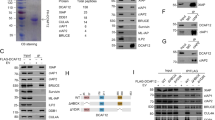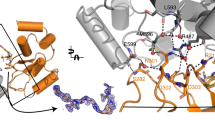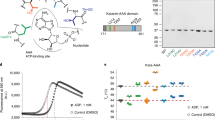ABSTRACT
IAPs (inhibitors of apoptosis) are a family of proteins containing one or more characteristic BIR domains. These proteins have multiple biological activities that include binding and inhibiting caspases, regulating cell cycle progression, and modulating receptor-mediated signal transduction. Our recent studies found the IAP family members XIAP and c-IAP1 are ubiquitinated and degraded in proteasomes in response to apoptotic stimuli in T cells, and their degradation appears to be important for T cells to commit to death. In addition to three BIR domains, each of these IAPs also contains a RING finger domain. We found this region confers ubiquitin protease ligase (E3) activity to IAPs, and is responsible for the auto-ubiquitination and degradation of IAPs after an apoptotic stimulus. Given the fact that IAPs can bind a variety of proteins, such as caspases and TRAFs, it will be of interest to characterize potential substrates of the E3 activity of IAPs and the effects of ubiquitination by IAPs on signal transduction, cell cycle, and apoptosis.
Similar content being viewed by others
Log in or create a free account to read this content
Gain free access to this article, as well as selected content from this journal and more on nature.com
or
Abbreviations
- IAP:
-
inhibitors of apoptosis
- BIR:
-
baculovirus IAP repeats
- E1:
-
ubiquitin-activating enzyme
- E2:
-
ubiquitin-conjugating enzyme
- E3:
-
ubiquitin protein ligase
- TNFR:
-
tumor necrosis factor receptor
- TRAF2:
-
tumor necrosis factor receptor associated factor-2
- JNK:
-
c-Jun N-terminal kinase
References
Crook NE, Clem RJ, Miller LK . An apoptosis-inhibiting baculovirus gene with a zinc finger-like motif. J Virol 1993; 67:2168–74.
Deveraux QL, Reed JC . IAP family proteins-suppressors of apoptosis. Genes Dev. 1999; 13:239–52.
Miller LK . An exegesis of IAPs: salvation and surprises from BIR motifs. Trends Cell Biol 1999; 9:323–8.
Borden KL . RING domains: master builders of molecular scaffolds? J Mol Biol 2000; 295:1103–12.
Hinds MG, Norton RS, Vaux DL, Day CL . Solution structure of a baculoviral inhibitor of apoptosis (IAP) repeat. Nat Struct Biol 1999; 6:648–51.
Sun C, Cai M, Gunasekera AH, et al. NMR structure and mutagenesis of the inhibitor-of-apoptosis protein XIAP. Nature 1999; 401:818–22.
Deveraux QL, Takahashi R, Salvesen GS, Reed JC . X-linked IAP is a direct inhibitor of cell-death proteases. Nature 1997; 388:300–4.
Roy N, Deveraux QL, Takahashi R, Salvesen GS, Reed JC . The c-IAP-1 and c-IAP-2 proteins are direct inhibitors of specific caspases. EMBO J 1997; 16:6914–25.
Takahashi R, Deveraux Q, Tamm I, et al. A single BIR domain of XIAP sufficient for inhibiting caspases. J Biol Chem 1998; 273:7787–90.
Deveraux QL, Roy N, Stennicke HR, et al. IAPs block apoptotic events induced by caspase-8 and cytochrome c by direct inhibition of distinct caspases. EMBO J 1998; 17:2215–23.
Deveraux QL, Leo E, Stennicke HR, Welsh K, Salvesen GS, Reed JC . Cleavage of human inhibitor of apoptosis protein XIAP results in fragments with distinct specificities for caspases. EMBO J 1999; 18:5242–51.
Huang Q, Deveraux QL, Maeda S, et al. Evolutionary conservation of apoptosis mechanisms: lepidopteran and baculoviral inhibitor of apoptosis proteins are inhibitors of mammalian caspase-9. Proc Natl Acad Sci USA 2000; 97:1427–32.
Rothe M, Pan MG, Henzel WJ, Ayres TM, Goeddel DV . The TNFR2-TRAF signaling complex contains two novel proteins related to baculoviral inhibitor of apoptosis proteins. Cell 1995; 83:1243–52.
Kaufman DR, Choi Y . Signaling by tumor necrosis factor receptors: pathways, paradigms and targets for therapeutic modulation. Int Rev Immunol 1999; 18:405–27.
Chu ZL, McKinsey TA, Liu L, Gentry JJ, Malim MH, Ballard DW . Suppression of tumor necrosis factor-induced cell death by inhibitor of apoptosis c-IAP2 is under NF-kappaB control. Proc Natl Acad Sci USA 1997; 94:10057–62.
Wang CY, Mayo MW, Korneluk RG, Goeddel DV, Baldwin ASJ . NF-kappaB antiapoptosis: induction of TRAF1 and TRAF2 and c-IAP1 and c-IAP2 to suppress caspase-8 activation. Science 1998; 281:1680–3.
Van Antwerp DJ, Martin SJ, Verma IM, Green DR . Inhibition of TNF-induced apoptosis by NF-kappa B. Trends Cell Biol 1998; 8:107–11.
Westwick JK, Weitzel C, Minden A, Karin M, Brenner DA . Tumor necrosis factor alpha stimulates AP-1 activity through prolonged activation of the c-Jun kinase. J Biol Chem 1994; 269:26396–401.
Yeh WC, Shahinian A, Speiser D, et al. Early lethality, functional NF-kappaB activation, and increased sensitivity to TNF-induced cell death in TRAF2-deficient mice. Immunity 1997; 7:715–25.
Oeda E, Oka Y, Miyazono K, Kawabata M . Interaction of Drosophila inhibitors of apoptosis with thick veins, a type I serine/threonine kinase receptor for decapentaplegic. J Biol Chem 1998; 273:9353–6.
Yamaguchi K, Nagai S, Ninomiya-Tsuji J, et al. XIAP, a cellular member of the inhibitor of apoptosis protein family, links the receptors to TAB1-TAK1 in the BMP signaling pathway. EMBO J 1999; 18:179–87.
Sanna MG, Duckett CS, Richter BW, Thompson CB, Ulevitch RJ . Selective activation of JNK1 is necessary for the anti-apoptotic activity of hILP. Proc Natl Acad Sci USA 1998;,b> 95:6015–20.
Massague J . TGF-beta signal transduction. Annu Rev Biochem 1998; 67:753–91.
Ambrosini G, Adida C, Altieri DC . A novel anti-apoptosis gene, survivin, expressed in cancer and lymphoma. Nat Med 1997; 3:917–21.
Tamm I, Wang Y, Sausville E, et al. IAP-family protein survivin inhibits caspase activity and apoptosis induced by Fas (CD95), Bax, caspases, and anticancer drugs. Cancer Res 1998; 58:5315–20.
Kobayashi K, Hatano M, Otaki M, Ogasawara T, Tokuhisa T . Expression of a murine homologue of the inhibitor of apoptosis protein is related to cell proliferation. Proc Natl Acad Sci USA 1999; 96:1457–62.
Li F, Ambrosini G, Chu EY, et al. Control of apoptosis and mitotic spindle checkpoint by survivin. Nature 1998; 396:580–4.
Ambrosini G, Adida C, Sirugo G, Altieri DC . Induction of apoptosis and inhibition of cell proliferation by survivin gene targeting. J Biol Chem 1998; 273:11177–82.
Li F, Ackermann EJ, Bennett CF, et al. Pleiotropic cell-division defects and apoptosis induced by interference with survivin function. Nat Cell Biol 1999; 1:461–6.
Fraser AG, James C, Evan GI, Hengartner MO . Caenorhabditis elegans inhibitor of apoptosis protein (IAP) homologue BIR-1 plays a conserved role in cytokinesis. Curr Biol 1999; 9:292–301.
Uren AG, Beilharz T, O'Connell MJ, et al. Role for yeast inhibitor of apoptosis (IAP)-like proteins in cell division. Proc Natl Acad Sci USA 1999; 96:10170–75.
Weissman AM . Regulating protein degradation by ubiquitination. Immunol Today 1997; 18:189–98.
Rock KL, Goldberg AL . Degradation of cell proteins and the generation of MHC class I-presented peptides. Annu Rev Immunol 1999; 17:739–79.
Hershko A, Ciechanover A . The ubiquitin system. Annu Rev Biochem 1998; 67:425–79.
Orlowski RZ . The role of the ubiquitin-proteasome pathway in apoptosis. Cell Death Differ 1999; 6:303–13.
Grimm LM, Goldberg AL, Poirier GG, Schwartz LM, Osborne BA . Proteasomes play an essential role in thymocyte apoptosis. EMBO J 1996; 15:3835–44.
Yang Y, Fang S, Jensen JP, Weissman AM, Ashwell JD . Ubiquitin protein ligase activity of IAPs and their degradation in proteasomes in response to apoptotic stimuli. Science 2000; 288:874–7.
Hay BA, Wassarman DA, Rubin GM . Drosophila homologs of baculovirus inhibitor of apoptosis proteins function to block cell death. Cell 1995; 83:1253–62.
Hauser HP, Bardroff M, Pyrowolakis G, Jentsch S . A giant ubiquitin-conjugating enzyme related to IAP apoptosis inhibitors. J Cell Biol 1998; 141:1415–22.
Chen Z, Naito M, Hori S, Mashima T, Yamori T, Tsuruo T . A human IAP-family gene, apollon, expressed in human brain cancer cells. Biochem Biophys Res Commun 1999; 264:847–54.
Jentsch S, Seufert W, Sommer T, Reins HA . Ubiquitin- conjugating enzymes: novel regulators of eukaryotic cells. Trends Biochem Sci 1990; 15:195–98.
Tyers M, Willems AR . One ring to rule a superfamily of E3 ubiquitin ligases. Science 1999; 284:601–4.
Lorick KL, Jensen JP, Fang S, Ong AM, Hatakeyama S, Weissman AM . RING fingers mediate ubiquitin-conjugating enzyme (E2)-dependent ubiquitination. Proc Natl Acad Sci USA 1999; 96:11364–69.
Joazeiro CA, Wing SS, Huang H, Leverson JD, Hunter T, Liu YC . The tyrosine kinase negative regulator c-Cbl as a RING-type, E2- dependent ubiquitin- protein ligase [see comments]. Science 1999; 286:309–12.
Fang S, Jensen JP, Ludwig RL, Vousden KH, Weissman AM . Mdm2 is a RING finger-dependent ubiquitin protein ligase for itself and p53. J Biol Chem 2000; 275:8945–51.
Waterman H, Levkowitz G, Alroy I, Yarden Y . The RING finger of c-Cbl mediates desensitization of the epidermal growth factor receptor. J Biol Chem 1999; 274:22151–54.
Yokouchi M, Kondo T, Houghton A, et al. Ligand-induced ubiquitination of the epidermal growth factor receptor involves the interaction of the c-Cbl RING finger and UbcH7. J Biol Chem 1999; 274:31707–12.
HK H, Joazeiro CA, Bonfoco E, Kamada S, Leverson JD, Hunter T . The Inhibitor of Apoptosis, cIAP1, Functions as a Ubiquitin-Protein Ligase and Promotes in vitro Ubiquitination of caspases-3 and -7. J Biol Chem 2000.
Acknowledgements
We thank Dr. Jonathan D. Ashwell for discussions and critical reading of this review.
Author information
Authors and Affiliations
Corresponding author
Rights and permissions
About this article
Cite this article
YANG, Y., LI, X. The IAP family: endogenous caspase inhibitors with multiple biological activities. Cell Res 10, 169–177 (2000). https://doi.org/10.1038/sj.cr.7290046
Issue date:
DOI: https://doi.org/10.1038/sj.cr.7290046
Keywords
This article is cited by
-
BRD7 inhibits enhancer activity and expression of BIRC2 to suppress tumor growth and metastasis in nasopharyngeal carcinoma
Cell Death & Disease (2023)
-
Increased migration and motility in XIAP-null cells mediated by the C-RAF protein kinase
Scientific Reports (2022)
-
DCAF12 promotes apoptosis and inhibits NF-κB activation by acting as an endogenous antagonist of IAPs
Oncogene (2022)
-
RNA-Seq analysis reveals potential regulators of programmed cell death and leaf remodelling in lace plant (Aponogeton madagascariensis)
BMC Plant Biology (2021)
-
Illumina sequencing revealed roles of microRNAs in different aluminum tolerance of two citrus species
Physiology and Molecular Biology of Plants (2020)



